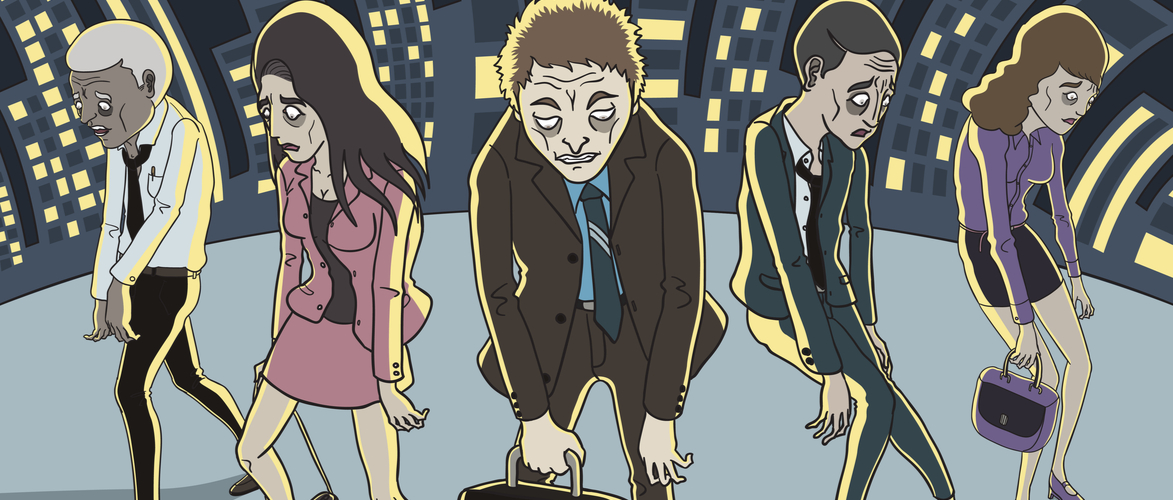
by American Business Women's Association | Apr 3, 2023 | Blog
Every year in the spring, Amy B., a buyer for a large retail chain store, hosts an Easter egg decorating teambuilding party, where she and a bunch of her suppliers spend an entire afternoon coloring and bedazzling hard-boiled eggs. None of them bring their kids—they do this for the sheer pleasure of out-of-the office bonding, creating interesting and attractive objects. The group is always amazed at the creativity of the resulting eggs. (And in case you’re wondering, no, none of them are artists.)
So why, as adults, don’t people exercise their inner child-like creativity more often? And what is it about the Easter egg party that allows them to so freely generate and express such range and diversity of ideas? There are several factors—all of which also apply to innovation.
Each egg represents a very low commitment.
It is cheap in both time and materials to try any idea they think of, so they try lots of ideas. If one doesn’t work, it doesn’t matter—it’s just one egg. Similarly, in your innovation work, you need to consider and try out many ideas, to ensure that only the best ones move forward. As innovation projects proceed through a company, they get more expensive—in money, time, and labor—at each successive phase. Developing Fail Fast, Fail Cheap methodologies allows you to try out lots of ideas early on, while it’s still cheap.
They leverage not only individual creativity, but also use the power of the group.
Someone will think of an idea to try, and then toss it out to the group. Then everyone contributes ideas for how best to accomplish it. No one ever says, “Yes, but that won’t work.” Everyone just thinks of ways to help make it better. The resulting final solutions are nearly always significantly better than what the person would have tried originally.
In many companies, the “Yes, But” phenomenon is all too common, and can be very damaging to creativity and innovation. Most ideas aren’t perfect when they’re first conceived, but teams act like they should be. They point out all the problems in an emerging idea before they ever attempt to find out if there’s anything good about it. For innovation and creative problem solving to thrive, it’s critical to create an environment that nurtures ideas rather than stifles them, so you get the benefit of the best thinking of the entire team.
They are willing to start over when something clearly isn’t working.
One woman brought eggs that were not naturally white; instead, they were brown. It wasn’t clear that dyeing them would work very well, if at all. And, in fact, the first few attempts didn’t work. So, she scraped off all the color on her unsuccessful eggs several times. But when she chose red, yellow, and orange colors and left them in the dye bath long enough, she got some of the most uniquely rich and vividly colored eggs anyone had ever seen.
Unfortunately, in large organizations, too many innovation projects that aren’t quite hitting the mark proceed too far. It’s important to recognize when an idea isn’t working, and then be willing to start again when you need to.
Reframing the goal results in more divergent ideas.
The woman with the brown eggs also tried other methods of decorating the eggs, not just coloring them with dye. Once she reframed the problem from coloring eggs to decorating eggs, everyone else also began creating the most innovative and unusual eggs of all. This reframing of the problem is a critical step in effective problem-solving and innovation. This is because the way a problem is stated affects the potential solutions you will think of. So when addressing any obstacle, it’s a good idea to question the way the challenge or problem is worded, to see if you can reframe it to get to different and better solutions.
So the next time you find yourself with eggs to decorate—or a challenge to meet—keep these tips in mind to help you think more creatively and come up with more innovative solutions.
- Fail fast, fail cheap. Test many possible ideas.
- Leverage individual and group creativity; “Yes, and” instead of “Yes, but”.
- Be willing to start over when the idea isn’t working.
- Reframe the opportunity to expand your thinking.
About the Author:
Susan Robertson empowers individuals, teams, and organizations to more nimbly adapt to change, by transforming thinking from “why we can’t” to “how might we?” She is a creative thinking expert with over 20 years of experience speaking and coaching in Fortune 500 companies. As an instructor on applied creativity at Harvard, Susan brings a scientific foundation to enhancing human creativity. To learn more, please go to: SusanRobertsonSpeaker.com.

by Rene Street | Mar 30, 2023 | Blog, Uncategorized
There’s never a perfect time to pause your day-to-day work and focus on the internal team, but when you do make the effort, the dividends are immediate. Setting aside an hour, a half-day, a two-day retreat or anything you can manage as a team will provide the opportunity to gather together, grow as a team and refill your collective energy tank in order to bust out of service fatigue and return to delivering excellent customer service in every interaction.
Refill the Team’s Energy
Your first step to regaining the capacity to do your work at your fullest potential is to heighten self-awareness and lean into the responsibility that you must refill your tank. Just like a video game avatar who seizes every opportunity to grab more energy for their harrowing journey ahead, you also need to seek out and embrace the chance to replenish yourselves wherever you find it. The good news is there are easy, actionable ways to find and create more energy for yourself and your whole team. It starts with committing to a “Gather and Grow” mentality that brings a team together (virtually or in person) and facilitates the kind of growth that fills your team’s energy tank and returns your business to a thriving state in the marketplace.
This four-step G.R.O.W. process will show you exactly how.
G – Game On!
Gaming at work might not be an intuitive way to encourage your team to spend their time. But gaming on the job is an easy way to bring hearts and minds together in pursuit of your common professional goals. Friendly sales competitions, staff meetings with moments of levity, and experiential outings with your team are all impactful ways to bust out of service fatigue. To take your workplace gaming to the next level, consider uniting over a cooperative strategy that can break the boredom or monotony of a day. You can boost teamwork qualities through games that bring a team around a collective purpose and goal. These types of efforts are shown to reduce stress and help participants cope with work-related fatigue.
R – Rule Reminders
It seems every business needed to adjust rules, policies, and offerings over the last two years to accommodate the global crisis. Process procedures changed for everything from hotel housekeeping to checking out books from your local library! Frequent change without strong internal communication leads to trouble. Making time to “accuracy audit” will help your team find their footing again when it comes to customer instruction.
Conducting an accuracy audit is easier than it sounds, and it’s the perfect agenda for the next time the team gathers together. Does your website match the current offerings? Do all members of the team know the current rules, even if they only work a few hours a week? Is everyone clear on the current processes of your organization internally and externally? Francis Ford Coppola, the famous film director, was once asked what his secret to success is. He answered, “The first thing I do is make sure that everyone is set is making the same movie.” You are the director of your workplace set. Get all the characters on the same page.
O – Optimism
The dedication to sincerely working toward a better tomorrow is imperative for personal and professional growth. That’s not to say that finding the silver lining in every situation is easy. Far from it. However, when a crowd gathers, its members can feed off each other’s attitudes, mindsets, and perceptions, the good and bad vibes quickly dominoing from one person to the next. For example, observe any boat-rocker on staff who starts a rumor laced with a little over-the-top emotion and see how fast the fire spreads ill-will among the team. Disaster!
However, only you can prevent forest fires! Take the time to gather regularly (even if in a virtual format) and stay in positive communication to decrease the chance of an unnecessary negative spark. Strive to provide frequent updates, truthful status reports, and lead by example with your own optimistic attitude.
W – Warm Welcomes
The odds are good that when your team gathers the next time, there will be new faces on board. Don’t underestimate the power of a warm welcome. No one likes the feeling of being the “new kid in school” and your compassion and kindness (regardless of your position at the company) can go a long way to get new staff off to a great start with the team. Remember to share those unwritten rules everyone else knows about (like, “Use any coffee mug except the purple one with the smiley face. That’s Sandy’s and you all know not to touch it.”) Consider assigning a first-week buddy to each new team member to help shave the learning curve and make them feel at more at home.
Making the time to G.R.O.W. (group gaming, rules review, optimistic outlooks, and warm welcomes) will reboot the energy tank of your organization and make sure everyone is busting out of Service Fatigue with full power and a positive outlook.
About the Author, Laurie Guest
A Hall of Fame keynote speaker and author, Laurie Guest, CSP, CPAE, is an authority on customer service excellence. Laurie blends real-life examples and proven action steps for improvement. She is the author of two books and is writing a third on the topic of service fatigue. To learn more or connect with Laurie, visit www.LaurieGuest.com

by American Business Women's Association | Jan 26, 2023 | Blog, Uncategorized
Being on video and watching videos is today’s business norm. A recent survey showed 76% of consumers watched a video before purchasing a product. Social media influencers promote products through video-based storytelling. You login to video meetings daily with prospects and customers.
Since 2005, the year YouTube launched, video has increasingly grown in prevalence, production value, and consumption. Then in 2020 video marketing took a massive leap forward with the pandemic-induced use of video conferencing, podcasts (with video), and livestreams.
Today, YouTube is the most used social platform for research purposes among business-to-business decisions makers with 50.9% of users. And every day more than 300 million people participate in a Zoom meeting.
The reluctant say about video meetings, “It’s not going away.” Strategic leaders, though, say, “Video is how we do business now.”
In today’s business world all video is video content marketing. Zoom is not a phone call with video. Whether it’s a livestream or a self-produced YouTube short, your videos still need to follow a handful of rules.
Positioning
Some marketers consider the word brand to be a four-letter word. The job of marketers and business leaders, they say, is to position a company or product in the market.
The brand becomes how customers define it, and, hopefully, they define it based on your considerable efforts.
The best marketers see this work of positioning to be the first and most important activity. They have learned to be comfortable with discomfort, because good positioning feels limiting. Good positioning is uncomfortably narrow.
It’s a single, narrowly defined target buyer. Your videos—live and recorded—will improve once you know who you are producing them for and what their motivations are.
Differentiation
What makes you different is what gets people’s attention. Not different for different sake, but a viable, propositional difference which appeals to your ideal buyer.
It’s a noisy, messy, and chaotic market. You want to be a brand which means you can charge a premium. If there is nothing to distinguish yourself from the competition, then you’re a commodity and you can only compete on price.
Your differentiation needs to be relevant and clearly expressed on all your video channels, especially video meetings. The first step is to shift responsibility for video meetings from operations to marketing. The next step, especially with a hybrid workforce, is to make sure that everyone who shows up on video is well trained and that their presence represents the value of the brand.
Distribution
Where to post your videos is determined by positioning and differentiation, not trend or fashion. A fishing guide once said, “You’re not fishing unless you have fish under your boat.” Or as Maverick said to Goose in the first Top Gun, “Target rich environment.”
Distribution can include everything from the social media platform (LinkedIn, TikTok) to the video distributor (YouTube, Vimeo) to the livestream platform. It answers what and how of your video content strategy.
Regardless of platform, you want all your videos to do one thing: direct interested parties to your website. There they learn more about you and begin to fall in love with you.
Distribution isn’t a benign decision. It says a lot about who you are and the people you’re trying to reach.
Story
Stories draw prospects in and customers closer. A well-told story engages the right people into a deeper, more meaningful conversation.
The right story you want to tell elevates the customer as hero. It captures your positioning and differentiation. How you will tell your story—written, audible, or visual—will be determined by the platform you choose and the audience you want to reach.
Tiktok is both a genre of video and a distribution platform. The audience consumes video through a spontaneous scroll. How you tell your story on TikTok may not work on LinkedIn.
Additionally, your video meetings, podcasts, and livestream productions express the story of your brand. The way you show up on video tells a story. But is it the right story? Your video meetings and podcast presence need to set the tone and timbre of future engagements.
Surprise
Better video is an act of kindness. Do everything you can to be more present across the lens.
We all spend enough time in front of a camera. When you show up on camera with a better-than-expected presence, you surprise people. Surprise is one ingredient in being unforgettable.
When you are not present, people check out. When you are present, people respond. Presence is what you say before you say a word.
Your presence should communicate confidence, power, and credibility. This will surprise some people. When combined with confidence, you’ll be more persuasive.
Conclusion
Video content is a critical component to your digital content marketing strategy. All video—whether meetings, podcasts, e-learning, or social media—deserve careful review and attention.
Video is a powerful and compelling medium. These five rules provide the framework you need to begin to evaluate what you’ve already produced and what you plan to produce.
Say to yourself, “Video is how we do business now.” Go and do it!
About the Author
Patrick McGowan, MBA, consults, trains, and coaches business executives and teams to have more power, presence, and credibility on-camera in a video-first market. He pulls together three-decades in marketing, innovation, and leadership. McGowan started Punchn to address the challenges and insecurities we all face when on camera. He is the author of “Across the Lens: How Your Zoom Presence Will Make or Break Your Success.”








